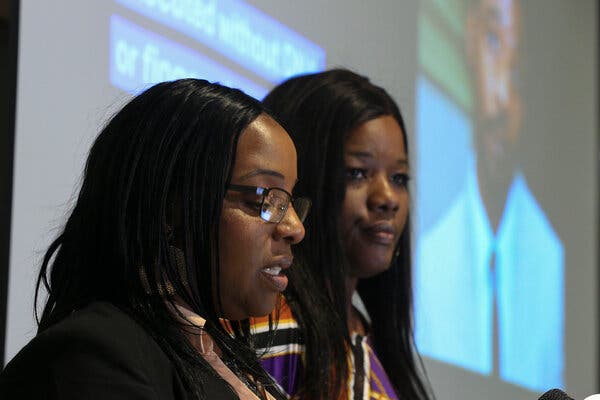
Lawyers’ request to conduct additional DNA testing before Ledell Lee was executed had been denied.
Source: After Ledell Lee’s Execution, Another Man’s DNA Is Found on the Murder Weapon – The New York Times
For 22 years, Ledell Lee maintained that he had been wrongly convicted of murder.
“My dying words will always be, as it has been, ‘I am an innocent man,’” he told the BBC in an interview published on April 19, 2017 — the day before officials in Arkansas administered the lethal injection.
Four years later, lawyers affiliated with the Innocence Project and the American Civil Liberties Union say DNA testing has revealed that genetic material on the murder weapon — which was never previously tested — in fact belongs to another man. In a highly unusual development for a case in which a person has already been convicted and executed, the new genetic profile has been uploaded to a national criminal database in an attempt to identify the mystery man.
Patricia Young, Mr. Lee’s sister, has been fighting for years to prove that it was not her brother who strangled and fatally bludgeoned the 26-year-old Debra Reese in Jacksonville, Ark., a suburb of Little Rock, in 1993.
“We are glad there is new evidence in the national DNA database and remain hopeful that there will be further information uncovered in the future,” Ms. Young said in a statement last week. In response to a lawsuit filed by Ms. Young in January, Jacksonville city officials released the bloody wooden club recovered from the victim’s bedroom, a bloody white shirt wrapped around the club and several other pieces of evidence for testing.
The Innocence Project and the A.C.L.U. have pushed for additional DNA testing at previous times, including the eve of Mr. Lee’s execution. The request was denied. A federal judge rejected Mr. Lee’s request for a stay of the execution, saying that he had “simply delayed too long,” according to a complaint filed by Ms. Young.

Mr. Lee’s execution, on April 20, 2017, was the first in Arkansas in more than a decade. Some accused the state of rushing Mr. Lee and several other prisoners to their deaths that month before the expiration of its supply of a lethal injection drug
At a news conference on Tuesday, Gov. Asa Hutchinson defended Mr. Lee’s execution. “It’s my duty to carry out the law,” he said, adding that “the fact is that the jury found him guilty based upon the information that they had.” He called the new DNA evidence that has emerged “inconclusive.”
In a statement, lawyers from the A.C.L.U. and the Innocence Project were cautious about stating what, exactly, could be extrapolated from the newly tested DNA from the shirt and the murder weapon — beyond the facts that both samples appeared to belong to the same man and that that man was not Mr. Lee.
“While the results obtained 29 years after the evidence was collected proved to be incomplete and partial, it is notable that there are now new DNA profiles that were not available during the trial or post-conviction proceedings in Mr. Lee’s case,” Nina Morrison, senior litigation counsel at the Innocence Project, said in the statement, which The Washington Post reported on Tuesday.
Uploading this newly generated profile to a national criminal database maintained by the F.B.I. has not yet provided a “hit,” she said. That means that the mystery man’s DNA does not match any of the DNA profiles that are already in the database, taken from people who were convicted or arrested on suspicion of violent crimes.
“However, the DNA profile will now remain in the database and will be automatically compared to all new profiles from convicted persons, arrestees or unsolved crimes that are entered in the future,” lawyers for the A.C.L.U., the Innocence Project and Ms. Young said in a joint statement.
According to the Innocence Project, no physical evidence was ever produced that connected Mr. Lee to Ms. Reese’s murder. In a summary of the case, the group also outlined obstacles that Mr. Lee had faced over the years, including a lawyer who was drunk and unprepared at court hearings, unreliable neighborhood eyewitnesses and conflicts of interest for key players.
Mr. Lee’s first trial resulted in a hung jury. His second murder trial began on Oct. 10, 1995, just seven days after O.J. Simpson had been acquitted of the murders of Nicole Brown Simpson and Ronald Goldman.
“Mr. Lee, a Black man charged with the vicious beating and murder of a white woman in her home, was tried under the shadow of the O.J. Simpson prosecution and trial,” Ms. Young argued in her January lawsuit. “The Simpson verdict shocked and angered many white Americans and polarized the nation along racial lines. It’s difficult to imagine that any jury could be truly objective in considering the evidence against Mr. Lee at that particular moment in time.”

Leslie Rutledge, the Arkansas attorney general, said on Thursday that she was not swayed by the new developments.
“The courts consistently rejected Ledell Lee’s frivolous claims because the evidence demonstrated beyond any shadow of a doubt that he murdered Debra Reese by beating her to death inside her home with a tire thumper,” she said in a statement, adding, “I am prayerful that Debra’s family has had closure following his lawful execution in 2017.”
Along with providing new DNA results, Ms. Young’s petition pushed the city of Jacksonville to compare fingerprints from the crime scene to a state and national fingerprint database for the first time. It has long been established that Mr. Lee’s fingerprints did not match any of those at the scene.
The resulting search against the national database did not provide a match, according to the Innocence Project and the A.C.L.U., but the Arkansas State Crime Laboratory has not yet searched the state database. If that search happens and a fingerprint match emerges, then the lawyers will push to compare that person’s DNA to the mystery man’s, they said.